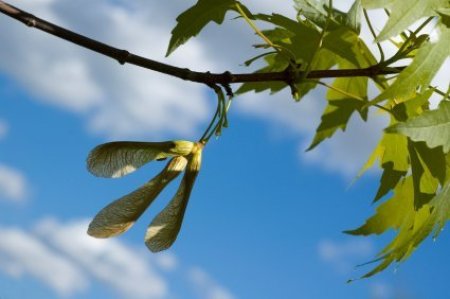Raising native tree species from seeds is a fun and rewarding process. It's also a fairly simple one. Although it is less expensive to grow trees from seed than it is to plant nursery-grown trees, what you save in money you'll probably make up for in time. Depending on the species of tree you plant, the process can be painfully slow. So if you're looking to grow native trees for the sake of their flowers, you're going to need to exercise some patience to see them reach their flowering size.
The first step in the planting process is to gather the desired seed. Choose seeds from healthy trees that have good form and are the dominant trees in stands of the same species. Plan to gather enough seeds to plant in several in small containers. Keep in mind that some will fail to germinate and others may just fail to survive.
Extracting seeds: Many seeds are surrounded by a protective coating that needs to be removed before planting. The coating on winged seed (maples, birches, ashes, and elms) can be removed by gently rubbing it between your finger and thumb. Seeds with a harder coating, like walnuts, may have to be removed with a knife. Pine and spruce cones can be placed in a paper bag and stored in a warm, dry place until the scales pop open and release the seeds into the bag.
Seed storage: Once the seeds have been extracted, dry them at room temperature and place them in a sealed plastic bag. (Don't forget to label them!) If you plan to store the seeds for an extended period of time, keep lilac, pear, and Caragana at room temperature. Most seeds need cold, dry conditions and store well in the refrigerator if kept in sealed plastic containers. Buckeye, walnut, maple, and oak prefer damp, cold conditions (33 F to 50 F).
As tree seeds mature, many undergo a natural period of dormancy. This is a survival mechanism designed to prevent seedlings from sprouting in the autumn and perishing during the cold winter months. In order for seeds to germinate, we must break this period of dormancy artificially. The type of dormancy that occurs varies according to the species. The most common types are mechanical (a hardening of the seed coat which prevents water from being taken up), or physiological (chemical inhibitors delay germination until there is a significant temperature change) or a combination of both (double dormancy). Most often, dormancy can be broken artificially by wearing away the seed coat or by chilling the seed.
Scarification (nicking the seed coat): Large seeds with very hard coverings like oaks (Quercus), may need to be nicked with a sharp knife or filed with coarse sand paper or an emery board to let in moisture. Smaller seeds that are not easily nicked by hand can be shaken in a jar lined with coarse sandpaper or partly filled with grit. Seeds from legumes like black locust (Robinia) or acacia should be left to soak in a container of hot water for approximately 24 hours in a ratio of 3 parts hot water to 1 part seed.
Stratification (cold treatment): Seeds of trees from temperate climates commonly need a period of cold treatment (stratification) to overcome dormancy. The seeds may be either sown outside so that they are chilled naturally over winter or stratified artificially in the refrigerator.If refrigerating your seed, mix it with moistened vermiculite, or peat and sand. Place it in a clear plastic bag, then seal the bag and put it in a refrigerator. Check the seed regularly through the unopened bag-it should be sown as soon as there are signs of germination.
The Montana State University Extension Service has put out this great resource guide listing what types of treatments are needed to break dormancy according each tree species.http://csfs.colostate.edu/pdfs/growseed.pdf
First fill the pots, pans, or seed trays with a high quality seed starting medium. Place large seeds or those that produce seedlings with long taps roots (oaks) in individual 4 to 6 inch pots. Cover the seeds to their own depth with the medium and firm to about ¼ inch below the rim. For large seeds like oak, leave the top of the seed exposed above the surface.
After sowing, thoroughly water all seeds from above with a hand-held mister. Temperate species can be kept in a cooler location (54-59 F) and warm-temperate and tropical species in a warmer location (70 F) until they germinate. Once the seeds have successfully germinated, move them into bright, indirect light and keep the growing medium consistently damp, but not wet. Spray them periodically with a fungicide to discourage damping off. When the seedlings are large enough to be handled, transplant them carefully into individual pots. Once hardened off, they may be planted outside when danger of frost has passed. Keep young seedlings well watered and weed free throughout the first season.

About The Author: Ellen Brown is an environmental writer and photographer and the owner of Sustainable Media, an environmental media company that specializes in helping businesses and organizations promote eco-friendly products and services. Contact her on the web at http://www.sustainable-media.com
Add your voice! Click below to comment. ThriftyFun is powered by your wisdom!